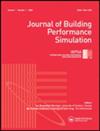衍生:耦合Modelica建筑图书馆和EnergyPlus,使新的能源系统和控制应用
IF 2.3
4区 工程技术
Q2 CONSTRUCTION & BUILDING TECHNOLOGY
引用次数: 0
摘要
Spawn是DOE的下一代工具链,用于整个建筑能源控制仿真。Spawn将传统的命令式基于负荷的包络建模与新的基于方程的暖通空调和控制建模相结合。Spawn使用EnergyPlus用于前者,Modelica建筑库用于后者。因为它利用了Modelica建筑图书馆,Spawn可以在建筑和区域尺度上评估先进的能源系统,包括新的建筑和带有存储的热泵系统的控制,以及这些系统与配电网络的耦合。Spawn的Modelica集成同样使它能够模拟现实的控制序列,因此可以桥接能量模拟和控制实现工作流程。从EnergyPlus中,Spawn继承了高效的包络模拟和使用现有包络模型创作工具的能力。本文描述了Spawn的体系结构和实现,它自动耦合Modelica和EnergyPlus进行运行时数据交换。本文最后以例子来说明Spawn的建模和仿真过程。本文章由计算机程序翻译,如有差异,请以英文原文为准。
Spawn: coupling Modelica Buildings Library and EnergyPlus to enable new energy system and control applications
Spawn is DOE's next-generation tool chain for whole building energy control simulation. Spawn couples traditional imperative load-based envelope modelling with new equation-based modelling of HVAC and controls. Spawn uses EnergyPlus for the former and the Modelica Buildings Library for the latter. Because it leverages the Modelica Buildings Library, Spawn can evaluate advanced energy systems at the building and district scale, including new architectures and controls for heat pump systems with storage, and the coupling of such systems to electrical distribution networks. Spawn's Modelica integration likewise enables it to simulate realistic control sequences and therefore to bridge energy simulation and control implementation workflows. From EnergyPlus, Spawn inherits efficient envelope simulation and the ability to use existing envelope model authoring tools. This paper describes the architecture and implementation of Spawn, which automatically couples Modelica and EnergyPlus for run-time data exchange. This paper closes with examples that illustrate Spawn's modelling and simulation processes.
求助全文
通过发布文献求助,成功后即可免费获取论文全文。
去求助
来源期刊

Journal of Building Performance Simulation
CONSTRUCTION & BUILDING TECHNOLOGY-
CiteScore
5.50
自引率
12.00%
发文量
55
审稿时长
12 months
期刊介绍:
The Journal of Building Performance Simulation (JBPS) aims to make a substantial and lasting contribution to the international building community by supporting our authors and the high-quality, original research they submit. The journal also offers a forum for original review papers and researched case studies
We welcome building performance simulation contributions that explore the following topics related to buildings and communities:
-Theoretical aspects related to modelling and simulating the physical processes (thermal, air flow, moisture, lighting, acoustics).
-Theoretical aspects related to modelling and simulating conventional and innovative energy conversion, storage, distribution, and control systems.
-Theoretical aspects related to occupants, weather data, and other boundary conditions.
-Methods and algorithms for optimizing the performance of buildings and communities and the systems which service them, including interaction with the electrical grid.
-Uncertainty, sensitivity analysis, and calibration.
-Methods and algorithms for validating models and for verifying solution methods and tools.
-Development and validation of controls-oriented models that are appropriate for model predictive control and/or automated fault detection and diagnostics.
-Techniques for educating and training tool users.
-Software development techniques and interoperability issues with direct applicability to building performance simulation.
-Case studies involving the application of building performance simulation for any stage of the design, construction, commissioning, operation, or management of buildings and the systems which service them are welcomed if they include validation or aspects that make a novel contribution to the knowledge base.
 求助内容:
求助内容: 应助结果提醒方式:
应助结果提醒方式:


